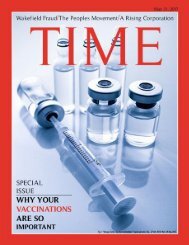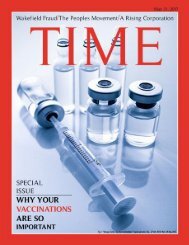JEP mag
Create successful ePaper yourself
Turn your PDF publications into a flip-book with our unique Google optimized e-Paper software.
depended on every single time, thus making<br />
this myth false. Measles in 1963 is<br />
an example of this, with nearly 400,000<br />
infected, it dropped to about 25,000 infected<br />
in 1970 because of vaccines. It is<br />
important to mention that hygiene and<br />
sanitation habits did not change much<br />
over this time period. “Similarly, with the<br />
Hib disease, rates went from 20,000 in<br />
1990 to around 1,500 in 1993 after the<br />
introduction of the vaccine” (Abraham<br />
para 5). If we were to cease giving vaccinations<br />
while keeping good hygiene,<br />
you would see an increase in infections.<br />
That is because vaccines are specially<br />
designed to combat a majority of infections,<br />
many of which are fatal to humans<br />
if they were to get them.<br />
at work is the MMR vaccination. The<br />
Andrew Wakefield case sparked fear in<br />
the people, and that lead to a greatly<br />
reduced amount of the MMR vaccination<br />
being received, and that lead to a measles,<br />
mumps and rubella outbreak within<br />
the United States and the United Kingdom.<br />
Those outbreaks could have easily<br />
been prevented if the people continued<br />
to vaccinate their children. No credible<br />
sources are available today that prove<br />
that vaccinations cause harm to the body,<br />
and are not worth the risk of getting. This<br />
is because the vaccinations are carefully<br />
crafted so that this is avoided.<br />
Myth #6- Vaccines aren’t worth the risk.<br />
Many parents think that vaccines are<br />
not worth the risk, but children have<br />
been vaccinated safely for decades, and<br />
no credible study has linked long term<br />
health conditions to vaccines. “The incidence<br />
of death is so rare from vaccines,<br />
it is about one per every 2 million injections”<br />
(Abraham para 6), making this<br />
myth false. Vaccinations when given to<br />
large populations are effective in preventing<br />
diseases from taking hold and<br />
ravaging the population. Previous strains<br />
of bacteria that killed off or left others<br />
disabled can now be prevented by vaccinations.<br />
An example of vaccinations<br />
Myth #7- Vaccines are something that<br />
can infect children with the disease that<br />
the vaccination is trying to prevent.<br />
In very rare cases, those who are vaccinated<br />
may get the symptoms of the<br />
disease that was trying to be prevented.<br />
“In fact, of the less than one in one million<br />
cases where someone does have the<br />
symptoms, they simply are experiencing<br />
a body’s immune system responding to<br />
the vaccine, not the actual disease itself.<br />
There has only been one recorded instance<br />
where a vaccine was proven to<br />
have caused a disease, and this was with<br />
the Oral Polio Vaccine, a vaccine that is<br />
no longer used today” (Abraham para<br />
7). Vaccinations within the United States<br />
are under the regulation of the Food<br />
and Drug Adminstration.<br />
2 TIME May 31, 2017<br />
Fig :“Handwashing: Clean Hands Save Lives.” Centers for Disease Control and Prevention. Centers for Disease Control and Prevention,<br />
27 Jan. 2016. Web. 30 May 2017.





